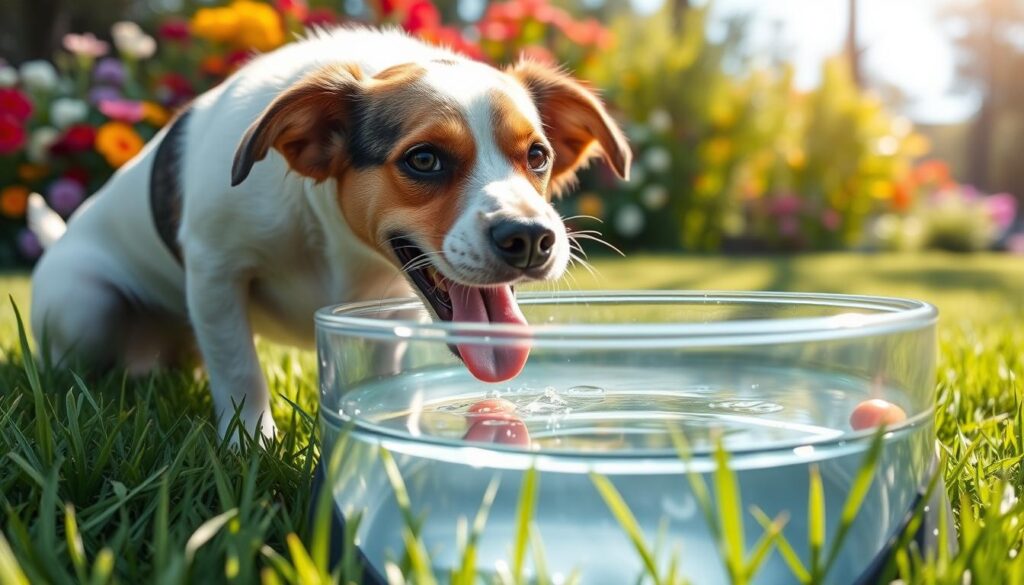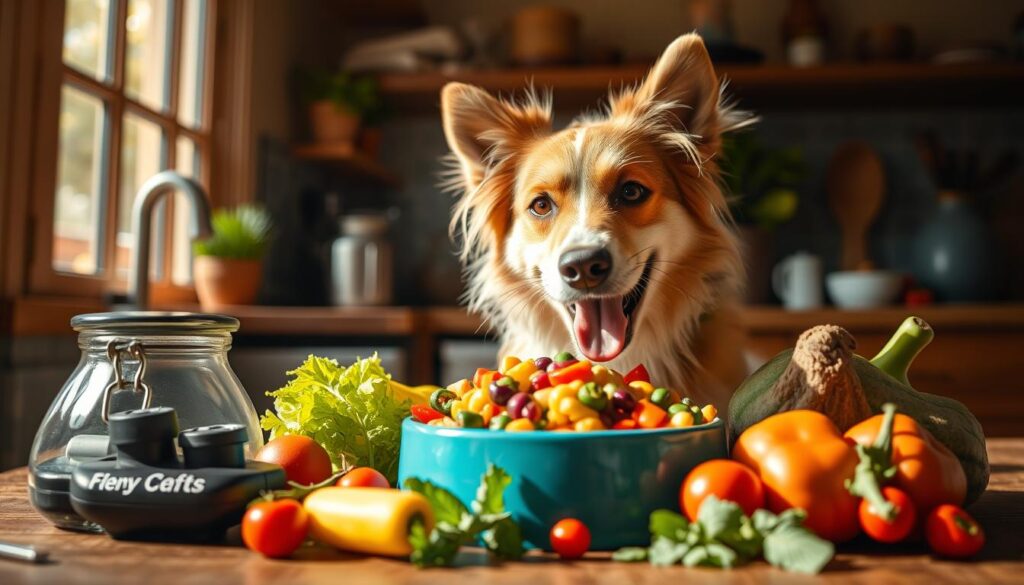As a devoted dog owner, the thought of your furry companion going without food can be unsettling. Whether it’s due to picky eating, illness, or unexpected circumstances, understanding the limits of a dog’s ability to survive without nourishment is crucial for their well-being. In this comprehensive guide, we’ll explore the safety parameters and critical timeframes to ensure your dog’s health and happiness remains a top priority.
Your dog’s life is precious, and their nutritional needs are just as important as your own. While the thought of a beloved pet refusing to eat may seem alarming, it’s essential to remain calm and focus on taking the necessary steps to address the underlying issue. By understanding the canine survival instinct and recognizing the warning signs of dangerous food deprivation, you’ll be better equipped to safeguard your furry friend’s well-being.
Table of Contents
Understanding Dogs’ Survival Without Food
Several factors affect how long a dog can go without eating. A healthy adult dog can usually go 3-5 days without food. But, this time can change based on the dog’s age, breed, size, and health.
Maximum Duration Without Eating
A healthy adult dog can survive for about three to five days without food (Barnette C., 2023). Puppies, however, should not go without food for more than 24 hours. This is because they need more energy and have less stored food (Wooten, S. & Barnette C., 2023).
Critical Time Frames for Different Age Groups
- Puppies: Can only survive up to 24 hours without food
- Adult Dogs: Can survive 3-5 days without food
- Older Dogs: May have reduced energy reserves, making them more vulnerable to the negative effects of food deprivation
Health Impact Factors
The ability of a dog to survive without food also depends on breed, size, and health. Larger dogs might have more energy reserves than smaller dogs. This could mean they can go longer without eating (Brookes, P., & Jiménez, A., 2021). Dogs with health issues or older dogs are more at risk from not eating (Harper, E., 1998).
| Factor | Impact on Survival |
|---|---|
| Breed | Different breeds have varying levels of endurance when it comes to surviving without food (Boom, K., Schoeman, J., Steyl, J., & Kohn, T., 2023) |
| Size | Larger dogs may have higher energy reserves compared to smaller dogs, potentially allowing them to last longer without food (Brookes, P., & Jiménez, A., 2021) |
| Health Condition | Older dogs or those with underlying health issues may be more vulnerable to the negative effects of food deprivation (Harper, E., 1998) |
Knowing what affects a dog’s survival without food is key to their care. If you have concerns about your dog’s health or a pet emergency related to food, see a vet.
Common Reasons Why Dogs Stop Eating
It’s worrying when our dogs suddenly stop eating. There are many reasons for this, from health issues to changes in their environment. Knowing these reasons helps us help our dogs stay healthy.
Medical problems like dental issues or infections can make dogs lose their appetite. Many healthy dogs eat only 60% to 70% of the food amount stated on packaging. A big drop in eating could mean a health issue. Vaccines can also affect a dog’s appetite.
Behavior and environment also matter. Travel and new places can make dogs not want to eat due to motion sickness or discomfort. Some dogs are picky or uncomfortable during meals. Making meals fun and reducing treats can help.
Age is another factor. Healthy senior dogs may eat less as they get older. Bad food, like expired or moldy food, can also make dogs not want to eat.
If a dog isn’t eating and has other symptoms like vomiting or lethargy, see a vet fast. Knowing why dogs stop eating helps us keep them healthy and well-fed.
| Reason for Decreased Appetite | Explanation |
|---|---|
| Medical Conditions | Dental problems, gastrointestinal disorders, infections, and adverse effects of vaccinations can impact a dog’s appetite. |
| Behavioral and Environmental Factors | Travel, unfamiliar surroundings, picky eating, and discomfort during mealtime can contribute to a dog not eating. |
| Age and Food Quality | Senior dogs may experience a slight decrease in appetite, and problems with the dog’s food can lead to a lack of interest in eating. |
By fixing the problems and making meals enjoyable, we can help our dogs eat well. This ensures they get the nutrition they need to stay healthy.
Physical Health Issues Affecting Dog’s Appetite
If your dog suddenly stops eating, it might be a sign of a health problem. Knowing the possible causes is key to keeping your dog healthy. Let’s look at some common health issues that can affect a dog’s appetite.
Dental Problems and Pain
Dental issues like tooth decay or gum disease can hurt your dog’s mouth. This pain might make them not want to eat. It’s important to take your dog for regular dental check-ups and brush their teeth to prevent these problems.
Gastrointestinal Disorders
Problems with the digestive system, like vomiting, diarrhea, or inflammatory bowel disease, can make your dog lose their appetite. These issues might make them feel sick or uncomfortable. If your dog is not eating, they need to see a vet right away.
Infections and Diseases
Diseases like kidney disease, liver disease, or cancer can also make your dog lose their appetite. As these conditions get worse, your dog might not want to eat as much. Regular vet visits are important to catch these problems early and keep your dog healthy.
Watching your dog’s eating habits closely is very important. If their appetite doesn’t come back in 24 hours, take them to the vet. This ensures your pet stays healthy and safe.
How Long Can a Dog Go Without Food
Dogs can survive 3-5 days without food, but it’s not good to let them go that long. Healthy adult dogs might last longer, but puppies and older dogs are at greater risk. In a study, a dog got intensive care and survived 27 days without eating.
Most dogs can skip meals for three days before they start eating again. Some can go up to five days without food. But, they must drink water to avoid dehydration. Healthy dogs can last seven days without food, but it’s best to see a vet before then.
Smaller dogs and puppies have less fat and need to eat more often than bigger dogs. Young, senior, underweight, or unhealthy dogs may get sick sooner if they don’t eat.
- A healthy adult dog can skip meals for a few days if they drink water. But, after three to five days without food, health problems can start.
- Different parts of a dog’s diet can affect how hungry they are. Foods with high digestible fibers can make them feel fuller.
- Dogs might not eat due to picky eating, stomach issues, medical problems, pain, or anxiety.
Signs of starvation in dogs include weight loss, muscle loss, poor coat and skin, low energy, and bad stool. If a very hungry dog eats too much food too fast, they can get refeeding syndrome.
Behavioral and Environmental Factors
A dog’s appetite isn’t just about physical health. Behavioral and environmental factors also play a big role. Stress, anxiety, changes in routine, and the food environment can all affect a dog’s appetite. These factors can make a dog not want to eat.
Stress and Anxiety Impact
Dogs are very sensitive. Changes or stress in their lives can make them lose their appetite. Events like moving, getting a new family member, or loud noises can make them anxious. It’s important to create a calm environment to help them eat again.
Changes in Routine
Dogs like things to be the same every day. Changes in their routine can upset them. This can include changes in feeding times or who takes care of them. Keeping things consistent helps them feel secure and interested in eating.
Food Environment Issues
Where a dog eats can also affect their appetite. Eating in a busy or noisy place can make them uncomfortable. It’s best to feed them in a quiet, clean spot. This makes them feel more at ease and encourages them to eat.
By focusing on these factors, pet owners can make mealtime better for their dogs. This helps their dogs stay healthy and happy.
The Critical Role of Water Intake
Water intake is key for pet nutrition and dog health. It’s even more important than food. Dogs can get very sick if they don’t have clean water for 24 hours. Dehydration is more dangerous than not eating.
Dogs need about one ounce of water for every pound they weigh. But, this can change based on their age, how active they are, and where they live. For example, dogs that are very active or live in hot places need more water.
Vets say dogs in emergency situations can’t go without water for three to four days. Dehydration can be deadly if not treated. Vets use tests to find out why a dog isn’t drinking enough.
Don’t force water on a dog that doesn’t want it. Instead, talk to a vet for help. Canned dog food can also help a dog drink more water.
Some dogs might not want to drink water because of health issues or dental problems. Dogs also use panting to cool down, which means they need enough water. This helps them stay cool and sharp.
To keep your dog hydrated, make sure they always have access to clean water. Wash their water bowls daily. You can also use water fountains and give them water-rich treats to encourage drinking.

Warning Signs of Dangerous Food Deprivation
It’s key to know the warning signs of food deprivation in pets. As a pet owner, being alert and quick to act is vital. Ignoring these signs can harm your dog’s health badly.
Physical Symptoms
Extreme lethargy and weakness are clear signs of food deprivation. If your dog seems very tired or weak, it’s a red flag. Losing a lot of weight, vomiting a lot, and diarrhea are also serious signs.
Behavioral Changes
Food deprivation can also change your dog’s behavior. If your dog is usually happy but now seems irritable or very tired, it’s a warning. These changes can mean your dog’s health is at risk.
Emergency Indicators
If you see these signs, get vet help fast. Food deprivation can quickly become dangerous. Quick action is key to keep your dog safe.
Being watchful and spotting early signs of food deprivation is crucial. It helps your dog get the care and food they need. Always prioritize your dog’s health and safety. Act fast if you notice any concerning changes.
Safe Methods to Encourage Eating
If your dog is not eating or has a decreased appetite, there are several safe and effective methods you can try. Regular exercise can help stimulate your dog’s appetite by boosting their metabolism. You can also try changing the location of your dog’s food bowl or offering high-quality pet nutrition formulas.
For dogs that are reluctant to eat, you can try tempting them with bland, palatable foods like unseasoned boiled chicken or meat-based baby food. Bone broth or cooked pumpkin can also be appealing when a dog’s appetite is low. However, it’s always best to consult your veterinarian before making significant changes to your dog’s diet.
CBD oil has also been shown to help increase appetite in some dogs. Always start with the lowest recommended dose and monitor your dog’s response. If the appetite issues persist or your dog exhibits any concerning symptoms, it’s crucial to seek veterinary attention promptly.

Maintaining proper dog care and nutrition is essential for your dog’s overall health and well-being. By incorporating these safe methods, you can help encourage your dog to eat and ensure they are getting the nourishment they need.
Dietary Transitions and Food Changes
Changing your dog’s food can be tricky. It’s important to introduce new foods slowly to avoid upset stomachs. Start by mixing the new food with the old, gradually adding more of the new over 1 to 2 weeks.
Think about your dog’s likes and any allergies when picking a new food. Switching flavors within the same brand is usually easier than switching brands. This slow transition helps your dog’s stomach get used to the new food.
- Slow transitions taking a week or more can help reduce digestive issues like loose stools or gas.
- Adding prebiotics and digestive enzymes during food transitions benefits most dogs, especially those with delicate stomachs.
- Dry matter analysis is essential for accurately comparing nutrients in different dog foods, as various forms have different moisture contents.
- A difference of 3% or more in fat content between dog foods requires a transition period double the recommended days.
Keep an eye on your dog’s weight and health during the change. Sudden changes in dog food can affect their weight. Weigh-ins and calorie checks are key. If your dog has a medical condition, a quick switch might be needed, but only with your vet’s advice.
| Transition Timeline | Old Food to New Food Ratio |
|---|---|
| Days 1-4 | 80% old, 20% new |
| Days 5-7 | 60% old, 40% new |
| Days 8-10 | 40% old, 60% new |
| Days 11-13 | 20% old, 80% new |
| Day 14 | 100% new |
Gradual changes are key when changing your dog’s pet nutrition. Slow, careful changes prevent stomach problems and other health issues. By following these steps, you can smoothly switch to a new food that’s right for your dog.
Medical Considerations and When to See a Vet
Watching your dog’s eating habits is very important. If they haven’t eaten in more than 48 hours, you should see a vet. Also, if they show signs of dehydration, are very tired, or are vomiting, they need to see a vet right away.
Emergency Situations
If your dog hasn’t had water for a day, they could be in big trouble. Also, if they suddenly go blind, have eye trauma, or show signs of an allergic reaction, you need to go to the vet fast.
Professional Intervention Guidelines
Your vet can help with both physical and behavioral issues that might make your dog not want to eat. They can do tests, give medicine, and tell you how to help your pet eat. If you’re worried about your dog’s pet emergency or health, call your vet.
Keeping your dog’s pet emergency and dog health safe is very important. By watching closely and getting help when needed, you can make sure your dog gets the care they need.
Prevention Strategies and Best Practices
To keep your dog healthy and interested in food, start with a regular feeding schedule. Make sure they get high-quality dog food in the right amounts. Don’t let them go too long without eating, as this can harm their health.
Keep your dog’s mind active with play, training, and fun activities. Regular vet visits are also key. They help spot and fix any health issues that might affect their appetite.
Always have fresh, clean water ready for your dog. Make sure they eat in a quiet, comfortable spot. By focusing on dog care and pet nutrition, you can avoid food deprivation and keep your dog happy and healthy.

